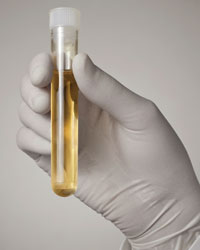From the case files...
Post date: 02/10/2014 | Time to read article: 5 minsThe information within this article was correct at the time of publishing. Last updated 18/05/2020
Each issue the team that bring you Casebook share interesting general practice cases
In this issue we bring you two interesting cases; the first encourages GPs to exercise caution when diagnosing haematuria, and the second highlights how various poor communication channels can have a negative impact on patient care.
Missed haematuria
 Mrs S, a 46-year-old female patient and infrequent attender visited her GP Dr Q with symptoms of increased urinary frequency. Mrs S had had a couple of urinary tract infections in the past, but was otherwise well. She had no other symptoms, but when Dr Q explored the history further, Mrs S explained that she had noticed a little blood in her urine that morning because she had experienced similar problems with UTIs in the past, was not particularly anxious about it.
Mrs S, a 46-year-old female patient and infrequent attender visited her GP Dr Q with symptoms of increased urinary frequency. Mrs S had had a couple of urinary tract infections in the past, but was otherwise well. She had no other symptoms, but when Dr Q explored the history further, Mrs S explained that she had noticed a little blood in her urine that morning because she had experienced similar problems with UTIs in the past, was not particularly anxious about it.
Dr Q asked Mrs S to produce a urine sample, which on dipstick testing demonstrated the presence of red blood cells (dipstick haematuria). Dr Q decided to send the urine sample for laboratory analysis and in the interim prescribed a three-day course of antibiotics for a suspected urinary tract infection.
Later in the week, the laboratory provided an interim urine microscopy result that demonstrated the presence of red blood cells, with the culture results pending. Dr Q was on annual leave so the results were reviewed by a Dr U, who filed the result as normal, before departing on a period of leave.
After the weekend, the culture result came back from the laboratory and it demonstrated no growth. Another GP colleague Dr S reviewed the result and filed it away as normal without reviewing the previous urine microscopy result.
Several months later, Mrs S represented with frank haematuria and weight loss. Dr Q referred her under the two-week rule for further investigation. Unfortunately, Mrs S was diagnosed with bladder carcinoma.
Mrs S pursued a complaint in relation to an alleged delay in diagnosis of bladder carcinoma. In the context of the investigation of Mrs S’s concerns, a significant event analysis was undertaken with reference to the relevant local NICE guidance (Urinary tract infection [lower] – women [with visible or non-visible haematuria]).
As a result of the significant event analysis, all the GPs and the practice nurses were updated in relation to the management of haematuria and a practice protocol was produced.
AdviceThis case highlights the difficulties that can arise when several different GPs are involved in the assessment of a patient, together with the analysis of the laboratory results. In this case, matters were further complicated by the fact that the results were returned from the laboratory in a piecemeal way. Frank or microscopic haematuria with no proven cause is potentially a sign of cancer of the bladder and renal tract and always needs to be taken seriously. This can be really difficult in general practice given the numbers of patients who present with urinary symptoms. Haematuria can be classified as:
The NICE guidance states for all women with visible or nonvisible haematuria: “If infection has been confirmed re-test the urine for blood with a dipstick after completing treatment with an appropriate antibiotic, to detect persistent haematuria. Persistence is defined as two out of three dipsticks positive for blood on separate occasions. Refer urgently for investigations of suspected urological cancer if:
In the case of Mrs S, referral under the two-week rule was indicated when an infection, but the presence of red blood cells, was not confirmed on urine culture. NICE are due to publish their guidance, Diagnosis and management of bladder cancer in February 2015. |
The Swiss Cheese
 Mrs X gave birth to J, a healthy baby boy. J was discharged, with a note in the records stating he was a “normal healthy infant”; a further note stated that, on examination, there was a bilateral red reflex.
Mrs X gave birth to J, a healthy baby boy. J was discharged, with a note in the records stating he was a “normal healthy infant”; a further note stated that, on examination, there was a bilateral red reflex.
At four weeks, the health visitor’s notes showed that J’s parents were concerned that J’s left eye was smaller than the right, and the health visitor referred the baby to a community paediatrician. A couple of weeks later, the health visitor documented the left eye as being more open and the referral was cancelled.
J was then seen by the family’s GP, Dr A, for a six-week check-up; his vision and hearing were recorded as being “satisfactory”. At three months, Dr A referred J to the ophthalmology department after noticing a squint in his left eye; the left pupil was also smaller than the right pupil. Six weeks later – before the ophthalmology consultation took place – J was admitted to hospital as an emergency via Dr A, with coryza, vomiting and poor feeding. J was transferred to the paediatric department, but there was no record from this admission of any examination of J’s eyes.
At six months, J’s ophthalmology appointment took place. He saw a consultant ophthalmologist, Dr H, who noted that she could not detect any visual acuity in the left eye and that the eye was microphthalmic. She also noted a central cataract on the left side. J eventually became blind in his left eye.
His parents made a claim against Dr A and the hospital for the delay in the diagnosis of the congenital cataract.
Expert opinion
Expert GP opinion on breach of duty stated that Dr A had not been diligent when initially examining J’s eyes at the time of the six-week check. By that time the health visitor had listed initial concerns about the size of the eyes, which should have prompted Dr A to be meticulous in his examination of the eyes; had the red reflex been absent, referral to a specialist should have occurred immediately. Prompt and appropriate referral would have led to a 20% chance of restoring J’s visual acuity to a level adequate for driving.
Another expert report, provided by a consultant ophthalmologist, also stated this examination was inadequate, as an abnormal red reflex would almost certainly have been present; this would have allowed for appropriate surgical intervention of the cataract that was later diagnosed.
This report also criticised the hospital paediatric department for failing to communicate the concerns in J’s records about his eye size to the appropriate colleagues. The case was settled for a substantial sum.
Learning points
This case appeared in the May 2014 edition of Casebook. Access more cases from the case report archive |
| « In the hot seat with... Professor Nigel Sparrow | The canary in the coalmine » |
Download a PDF of this edition
PDF


